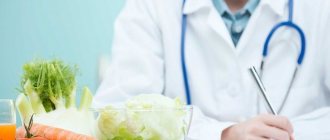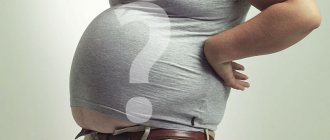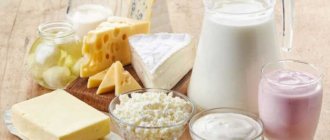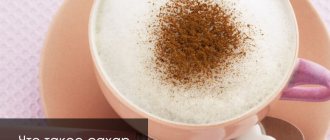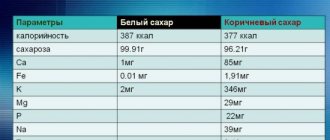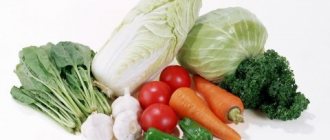In the control of type 1 diabetes, insulin therapy plays a major role. In type 2 of the disease, drugs retain an auxiliary function. The diet is also slightly different. In the first case, it is the background for treatment. In the second, nutrition takes center stage.
Drugs that lower blood sugar are commonly called tablets. This highlights their alternative to injections of the hormone insulin. Medicines are prescribed by an endocrinologist. It is necessary to know the general medical name of the group and the specific pharmacy name of the hypoglycemic agent.
What is hyperglycemia and why is it dangerous?
If the pancreas is not able to produce the amount of insulin necessary to utilize the glucose supplied with food (sugar) and contained in the body, hyperglycemia develops. Its clinical picture is characterized by:
- thirst, frequent urination;
- increased appetite;
- weakness, loss of strength;
- sudden deterioration of vision;
- a sharp deterioration in the ability of body tissues to regenerate.
The latter is manifested by the fact that even microtraumas take a very long time to heal, and purulent complications often develop.
A blood glucose level of 6.1 mmol/l is considered elevated. If the measurement shows this value, you need to take measures to reduce sugar. Untreated hyperglycemia leads to diabetes mellitus.
A reading below 3.3 mmol/l is hypoglycemia, a glucose level that is too low. You definitely need to know these numbers, since you need to carefully reduce high blood sugar: a rapid decrease can result in a hypoglycemic coma.
In such a situation, it is possible to manage without insulin only if you have type 2 diabetes (hence the second name - non-insulin-dependent form of diabetes). To normalize glucose levels, there are various ways:
- medications;
- ethnoscience;
- change in diet;
- physical exercise.
To correct hyperglycemia, it is best to use all methods, using an integrated approach to solving the problem.
Nutrition rules and healthy foods
When blood glucose levels rise, the first step to normalizing the levels is proper nutrition. Moderate hyperglycemia can be eliminated by adjusting the diet without resorting to synthetic drugs. If diabetes mellitus is diagnosed, the patient is prescribed therapeutic food “Table No. 9” (according to the classification of diets by V. Pevzner).
General catering conditions include:
- Absolutely no sugar. It is necessary to eliminate foods containing large amounts of simple carbohydrates from the diet (primarily desserts, sweet drinks, confectionery, etc.).
- Compliance with drinking regulations (from 1.5 to 2 liters of water per day) and food intake (you should eat every 3-4 hours).
- Control over the volume of portions (350 grams once) and caloric content of dishes (daily calorie intake should be within the range of 2200–2500 kcal).
- Exclusion of culinary processing of products by frying (stewed, baked in foil, boiled food is allowed).
- Introduction to the daily menu of foods with hypoglycemic properties.
- Eliminating fatty foods from the diet (pork, mayonnaise-based sauces, fast food, sausages, meat pates and canned fish).
- Strict limitation of alcoholic beverages (the permissible weekly portion of wine is 200 ml, the maximum dose of vodka for men is 100 ml, for women - 50 ml).
- Reducing the amount of table salt in prepared dishes.
The diet should be balanced in terms of nutrients (proteins, carbohydrates and fats). The recommended intake is 45% complex carbohydrates (porridge, vegetables, legume dishes), 25% protein (lean fish and meat, mushrooms, seafood, nuts), 30% fat. The consumption of animal fats must be halved, replacing them with vegetable oils. This will help reduce the negative impact on blood vessels.
Product selection
When creating a menu, special attention should be paid to the glycemic index of each individual product. The glycemic index (GI) is a conditional value that reflects the rate of formation of pure glucose in the liver and the speed of its absorption into the bloodstream. The higher the GI, the more intense the processing of foods and the release of glucose.
The GI allowed for diabetes is from 0 to 30 units. Products indexed up to 70 units are allowed to be consumed in doses. The limit is set according to the current level of glycemia, the presence of associated complications (including excess body weight), and prescribed medications. Foods with a glycemic index of 70 units or higher are prohibited.
Focusing on the energy value and GI of foods, a weekly menu is developed, which details specific dishes and drinks for each day. The basis of the diet should be vegetables (fresh, stewed, baked). Representatives of the vegetable group help stabilize blood sugar:
- Earthen pear (Jerusalem artichoke). The vegetable has a stimulating effect on intrasecretory processes in the pancreas. Enhances the synthesis of natural insulin.
- Bitter gourd (momordica). Promotes weight loss, activates insulin production, normalizes carbohydrate metabolism.
- Ginger root. Inhibits the absorption of glucose into the blood, strengthens blood vessels, improves immunity, and activates metabolic processes.
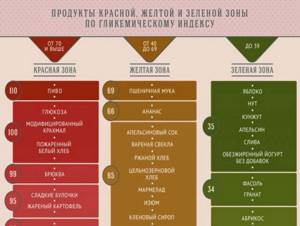
Fruits are allowed only those in which the content of glucose and fructose is reduced. This can be determined using the glycemic index table. Regular consumption of freshly squeezed juices helps to retain glucose and increase immune defense. To reduce the aggressive effect on the stomach, juices should be diluted with boiled water (in a 1:1 ratio) before drinking.
An effective way to reduce sugar is Jerusalem artichoke juice, squeezed from fresh tubers. To prepare the drink, the vegetable must be chopped (using a grater or meat grinder), and the juice must be squeezed out through cheesecloth. Dilute the drink with water and take half a glass.
Another healthy drink is prepared from chicory root. The product contains inulin, organic acids, vitamins, minerals, essential oils. Dried and crushed chicory roots are brewed with boiling water. You can purchase a ready-made Chicory drink at a pharmacy or store.
Important! Without changing your eating habits, you will not be able to lower your glucose concentration and control your glycemia. The basis for the well-being of a diabetic and a person prone to diabetes is proper nutrition.
Medications
If an increase in glucose levels is detected at a doctor’s appointment, after additional examination and confirmation of the diagnosis, a course of drug treatment is prescribed. This is regular therapy with daily medication, but sugar cannot be reduced to normal levels overnight. A one-time dose of medication is not enough; treatment is usually lifelong.
Drugs that are prescribed to lower blood sugar are divided into three groups.
- Some increase the sensitivity of receptors to insulin - these are Glucophage, Siofor.
- Others help the pancreas produce insulin to break down glucose (drugs Diabeton and Amaryl).
- Still others - Bayetta, Glucobay - slow down the absorption of carbohydrates in the intestine.

All three groups of medications are prescribed, which allows you to smoothly and effectively reduce sugar without complications. Selecting medications is the prerogative of the attending physician; taking medications on your own or replacing some medications with others can lead to complications. In addition, all drugs that help reduce sugar levels have contraindications.
Therefore, when choosing a medicine yourself, you need to know that the consequences of this may be:
- falling into a hypoglycemic coma;
- myocardial infarction;
- development of heart failure;
- vascular problems, high blood pressure and stroke;
- renal and liver failure;
- individual reaction to the components of the drug.
Important! During pregnancy and breastfeeding, taking sugar-lowering medications on your own is strictly prohibited.
Causes of increased blood glucose
Improper functioning of the pancreas, problems with glucose absorption, insulin deficiency, or tissue resistance to the action of an important hormone provoke the development of endocrine pathologies. The more negative factors, the more actively blood sugar rises.
Poor nutrition is one of the causes of metabolic disorders. Sweets, smoked, fatty foods, a lot of spices, passion for animal fats, vitamin deficiency negatively affects the pancreas, liver and digestive tract. Addiction to milk chocolate, jam, cakes, baked goods, increased appetite are signs of hormonal imbalance and endocrine diseases.
There are other provoking factors:
- genetic predisposition;
- physical inactivity;
- high level of stress in the family and at work;
- metabolic pathologies;
- diseases of the liver, pancreas and thyroid gland;
- metabolic syndrome;
- insulin resistance;
- frequent meals with simple carbohydrates;
- overwork, lack of sleep;
- drug addiction and alcoholism;
- pathology of the pituitary gland;
- hormonal disorders.
Find out about the norm of progesterone during pregnancy by week, as well as about safe ways to correct indicators. Read about the norm of blood sugar in women, as well as how to prepare for the test at this address.
Sugar is a crystalline substance that, after entering the body, is broken down into structural elements.
Its main components are fructose and glucose, which are absorbed into the blood and enter the brain, as well as all cells of the body.
Under the influence of certain factors, glucose can accumulate in the body in the form of glycogen. This substance is deposited in muscle tissue and liver.
If necessary, the substance is absorbed by the body so that the brain can receive the required amount of glucose if its supply from food stops for some reason.
Even though sugar is a plant product, it does not contain any beneficial substances such as vitamins or minerals. However, a certain amount of glucose and fructose is always necessary for the body and must be supplied in sufficient quantities from the food received.
The main reasons for increased sugar levels:
- Eating foods high in carbohydrates
- Increased physical activity
- Stress
- Infectious diseases that cause increased body temperature
- For epileptic seizures
- Pathologies of the gastrointestinal tract
Another common cause of increased blood sugar levels is diabetes.

This is a fairly serious disease in which the production of insulin is disrupted, as a result of which sugar has a negative effect on the condition of the blood and the entire body as a whole.
An important feature of diabetes mellitus is that
This disease in the early stages of development is latent. In view of this, in many cases the patient does not even suspect about the problem and finds out about it only after the disease has led to serious complications, which include stroke and heart attack.
Negative consequences can be prevented by timely normalization of the amount of sugar contained in the blood.
Deviations from the norm can be determined using a special analysis, which can be done in both private and public medical institutions.
In addition, you should pay attention to the state of your blood if you have certain symptoms.
Signs of increased glucose levels:
- Constant feeling of hunger while losing weight
- Extreme drowsiness
- Regular numbness in the hands
- Skin rashes and itching
- Poor tissue healing when damaged
- Exacerbation of chronic diseases
- Dry mouth
- Deterioration of visual acuity
The symptoms presented may indicate both short-term and long-term increases in blood sugar concentrations.
The constant manifestation of these signs is a reason to use the services of doctors and do a test to determine your blood sugar level.
In general, sugar performs an important function in the human body, but its excess, which can be observed for many reasons, leads to negative health consequences.
Traditional medicine recipes
You can safely bring your sugar levels back to normal using folk remedies. All these methods are used at home, the necessary ingredients are available and inexpensive, and the preparation methods are simple.
Juices
A useful and in most cases tasty sugar-lowering folk remedy is vegetable juice. A prerequisite is that it must be natural. Therefore, juices from the store are not suitable. You need to prepare fresh juice twice a day (morning and afternoon):
- tomatoes;
- pumpkins;
- zucchini;
- potatoes.
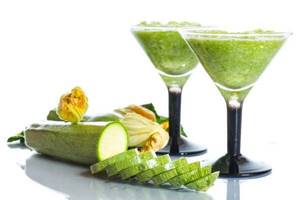
Potato juice has a unique taste. For pumpkin, only pulp is required; young zucchini and tomatoes are completely processed. You can also drink watermelon juice.
Bay leaf
If you urgently need to lower your sugar, you can make a decoction of bay leaves. It is boiled (15 sheets per one and a half glasses) for 5 minutes, after which the entire contents of the dish are poured into a thermos and infused for 3–4 hours. This remedy is drunk little by little so that the entire amount is consumed in a day.
Cinnamon
Cinnamon also reduces sugar: 1 tsp. powder per glass of low-fat kefir, mix and drink before bed.
Chicory and rosehip
For those who love tea and coffee, we can advise replacing them with drinks based on chicory: it is sold in stores in the section of products for diabetics. Dry or fresh rose hips can be poured with boiling water in a thermos and drunk instead of tea or coffee.
Cabbage
Regular consumption of sauerkraut brine helps reduce glucose levels. A glass per day, divided into three equal portions, is enough. Not recommended for gastritis and peptic ulcers.
Oats
Not lightning fast, but quickly enough you can reduce sugar with oatmeal broth: a glass of cereal with 3 cups of boiling water. Cook in a water bath for 15 minutes, let cool. Take 0.5 cups throughout the day.
Effective herbal remedies
Medicinal plants are another way to reduce sugar without drugs. Herbal remedies have virtually no contraindications. You can buy them at a herbal pharmacy or collect the raw materials yourself (but for this you need to have some skills and knowledge).
Herbs are a collective name because they use a variety of parts of herbaceous plants, shrubs and trees:
- roots (chicory, burdock, dandelion);
- leaves (nettle, blueberry, black currant);
- flowers (clover);
- buds (lilac);
- bark (aspen).
A decoction is made from fresh crushed chicory roots: 1 tsp. root a glass of boiling water, leave until it cools down. Take 1 tbsp. l. before eating.
Important! In herbal medicine, after a month of taking medicinal herbs, you need to check your glucose level. These drugs have a weak glucose-lowering effect and are indicated only in combination with a diet for mild type 2 diabetes.
Nettle leaves can be poured with boiling water and drunk after cooling, or you can make an alcoholic infusion: a bottle of vodka requires a full glass of chopped fresh leaves, leave for 14 days. Take diluted. Lilac buds, prepared before blossoming, are also infused with alcohol.
Methods for quickly lowering sugar at home
How can you lower blood sugar? Hyperglycemia is a dangerous condition. Therefore, it is better to immediately seek help from an endocrinologist if the pathology becomes chronic.
There are several ways to normalize your sugar levels during the day at home:
- taking medications (to be agreed with your doctor),
- diet,
- physical exercise,
- folk remedies.
On a note! It is recommended to combine several methods of lowering blood sugar at once in order to quickly achieve the desired result.
Nutrition correction
What foods lower blood sugar? To reduce glucose levels as quickly as possible, first of all, you need to adjust your diet. The main condition is to stop the intake of fast carbohydrates (sweets, baked goods, jam) into the body. Any foods that increase the concentration of sugar should be immediately excluded from the diet.
General nutrition rules:
- eat foods with a low glycemic index (lean meat, seafood, nuts, some vegetables (cucumber, red pepper, eggplant), sour fruits (grapefruit, cherry, lemon), greens,
- include more fiber-rich foods
- minimize the consumption of saturated fats,
- Among vegetable oils, it is better to give preference to olive instead of sunflower,
- eat often, in small portions, avoiding the appearance of a strong feeling of hunger,
- drink more water to speed up glucose elimination.
You need to be very careful when replacing sugar with other sweeteners. Uncontrolled use may cause undesirable effects (for example, intestinal dysfunction).
Foods that lower blood sugar:
- Blueberries contain myrtilline, which acts like insulin and reduces the concentration of glucose in the blood. In the early stages of diabetes, it is useful to drink an infusion of blueberry leaves. Fresh and frozen berries can be consumed in unlimited quantities.
- Jerusalem artichoke contains inulin and fructose, which stabilize metabolic processes. The vegetable can be eaten raw or made into a decoction: boil several tubers for 15 minutes in water. Drink 100 ml three times a day.
- Mix the juice of 1 lemon with 1 egg. Drink the product on an empty stomach for 3 days.
- Grind the horseradish root. Add it to the curdled milk (1:10). Take 1 spoon of the product before meals.
Phytotherapy
How to quickly lower blood sugar? Some plants help quickly normalize glucose levels:
- Dandelion root contains about 40% inulin, which is very beneficial for diabetics. To prepare the infusion, you need to grind 1 teaspoon of raw materials and leave for 20 minutes in a glass of boiling water. Drink ¼ glass 4-5 times a day.
- It is good to keep a nettle tincture on hand in case of hyperglycemia. Leave 200 g of plant leaves to infuse in 0.5 liters of vodka for 2 weeks. Take 1 spoon 30 minutes before meals.
- Grind burdock root, pour boiling water (1 spoon per 200 ml of water). Place in a water bath for 30 minutes. Drink 100 ml 3 times a day.
- Grind 1 tablespoon of flaxseed in a coffee grinder. Infuse in a glass of boiling water. Squeeze the juice from ½ lemon into the cooled infusion. Do not strain, drink it all at once 1-2 hours before meals.
- Boil 15 laurel leaves for 15 minutes in 1.5 glasses of water. Pour the broth into a thermos and leave for 3 hours. Drink the product throughout the day. After 3 days of treatment, pause for 14 days, then repeat taking the drug.
- Boil 20 g of walnut partitions in 200 ml of water for an hour. Allow the product to cool and take 1 spoon before meals.
Medications
Any medications that lower blood sugar must be prescribed by a doctor. Uncontrolled use of medications and non-compliance with the dosage can lead to the opposite effect and the development of hypoglycemia. It is imperative that drug therapy be consistent with the glycemic index of the foods consumed.
Drugs that lower blood sugar:
- sulfonylurea derivatives (Amaril, Diabeton, Gilemal) stimulate insulin synthesis, improve glucose utilization in tissues,
- incretins (Bagomet, Metglib, Janumet) gastrointestinal hormones that stimulate insulin secretion; when sugar levels are below 5.5 mmol/l, they stop stimulating its production, which helps prevent hypoglycemia,
- biguanides (Siofor, Gliformin) reduce insulin resistance.
Physical exercise
You can quickly and effectively lower sugar with the help of special exercises, which can be an addition to other treatment methods. They help absorb excess sugar into muscle tissue, reduce cholesterol levels, and improve overall well-being.
It is recommended to do 15 repetitions at first. Gradually the load can be increased:
- Hold dumbbells in each hand. Hands are lowered to the hips. Slowly bend and raise your arms.
- Lie on your back, put your hands behind your head, bend your legs. Tighten your abdominal muscles and lift your upper body.
- Lie on your stomach. Place your elbows below shoulder level and rest on your toes. Tighten your abs, raise your body to a small height. Hold for 5 seconds, return to the starting position.
When can you donate blood for hCG and in what cases is the test prescribed?
We have the answer! Read about where a person’s pancreas hurts and how to get rid of pain at this address.On the page https://fr-dc.ru/zabolevaniya/diabet/sahar-v-krovi-u-rebenka.html learn about the normal blood sugar level in children and the reasons for deviations in glucose levels.
Foods that lower blood sugar
If you have hyperglycemia, you need to reconsider your diet and adjust it - eat only healthy foods (in this case, their benefit is determined by the glycemic index). The list of permitted and recommended foods includes fruits with vegetables and herbs, seafood, lean meat and fish.
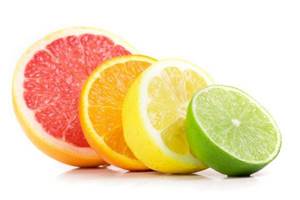
The following products are recommended for diabetics:
- For fruits, citrus fruits (grapefruit and lemon) are recommended, supplemented with berries - cherries, black currants, blueberries (they are also very good for vision).
- Vegetable dishes are prepared from zucchini, pumpkin, beets, radishes and carrots with the addition of lettuce and celery, seasoned with olive oil: it improves the absorption of insulin at the cellular level.
- Various nuts will reduce sugar and fill you up - from peanuts and almonds to cashews, dishes made from chicken and rabbit meat, sea and river fish.
- Porridge made from whole grains and boiled buckwheat are very healthy.
For nutrition to be as healthy as possible, you need to eat fractionally and in small portions. Bran bread is healthy.
A diet with high sugar levels should exclude sugar and saturated fats; you should drink at least 2 liters of water per day. Such nutrition will help not only normalize glucose, but also lose excess weight.
Physical exercise
Physical activity and normal exercise reduce blood sugar levels. You can both perform exercises and engage in physical labor - for example, chopping wood until you feel slightly tired.
Important! Before the analysis, you should lie down for some time or simply remain calm and avoid foods with a high glycemic index.
Exercises with dumbbells performed in a standing position have a good effect: slowly raising the arms from the hips above the head with gradual flexion and extension of the arms, lifting the dumbbells just above the shoulders with straightening the arms to the sides.
You can do the exercises while lying down: lie on your back with your legs bent and do push-ups, tensing your abdominal muscles and lifting yourself up slightly. In a position on your stomach, strain your abs so that your body rests on your toes and elbows (this exercise is called a plank and lasts no more than 5 seconds).
A rapid reduction in blood sugar must be carried out comprehensively, using the entire arsenal of means. In this case, it is necessary to regularly measure glucose levels to prevent hypoglycemia.
How to take a sugar test correctly
The first analysis is especially important, because it determines not only the type of diabetes, but also other diseases of the endocrine system. Therefore, before the analysis it is important to follow a diet, and also do it on an empty stomach.
To more accurately determine the nature of the disease, you may have blood drawn throughout the day or under a sugar load.
In any case, if you notice dry mouth, itching on the body, severe weakness, weight gain or extreme thinness, immediately get tested for sugar.
See also on the blog: Results of a general blood test
Dear readers! Do not succumb to this disease, fight with all available means, and, as you can see, there are many of them in the arsenal of medicine.
Blood tests for glucose levels are taken on an empty stomach strictly in the morning, only in this case they are quite accurate. The norm for a healthy person is 4.5−5.5 mmol/liter. When blood sugar drops below 3.5 mmol/l, hypoglycemia develops.
This happens extremely rarely in healthy people who do not suffer from diabetes. The fact is that when the body does not receive sugar from food, it begins to eat from glycogen reserves, first from the liver, then from muscles and finally from fat deposits.
So the blood sugar in a healthy person can fall below a certain level only in case of extreme exhaustion and prolonged fasting. In this case, a decrease in glucose levels is manifested by hunger, weakness, lethargy, and inhibition of the nervous system.
When the level of fasting blood sugar exceeds 7 mmol/liter or goes off scale 11.1 mmol/liter, then we are talking about hyperglycemia, a repeat test has to be prescribed, and a diagnosis of diabetes mellitus has to be made.
